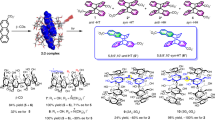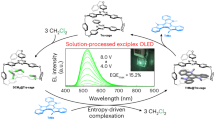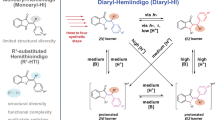Abstract
CYCLODEXTRINS and modified derivatives can bind, and sometimes modify the properties of, guest molecules in their torus-shaped cavities1,2. They have also been used as the building blocks of molecular materials and devices3. The propensity to bind and retain a guest is not easily predictable or controllable, however. There is currently much interest in the switching on and off of chemical4 and biological5 activity, particularly by photochemical means6, as such functions will be required of molecular-scale devices. Here we report the controlled binding and release of guest molecules in cyclodextrins modified with substituents that can reversibly form bridging units across the cavity openings. Irradiation of percinna-moylated α- or β-cyclodextrin in N-methylpyrrolidin-2-one (NMP) leads to the formation of intramolecular cyclobutane bridges which trap a bound NMP molecule. Irradiation at a different wavelength breaks open the cyclobutane rings and releases the guest.
This is a preview of subscription content, access via your institution
Access options
Subscribe to this journal
Receive 51 print issues and online access
$199.00 per year
only $3.90 per issue
Buy this article
- Purchase on Springer Link
- Instant access to full article PDF
Prices may be subject to local taxes which are calculated during checkout
Similar content being viewed by others
References
Carbohyd. Res. 192, 1–370 (1989).
Bender, M. L. & Komiyama, M. Cyclodextrin Chemistry (Springer, Berlin, 1978).
Duchene, D. (ed.) New Trends in Cyclodextrins and Derivatives (Editions de Sante, Paris, 1991).
Vogtle, F. Supramolecular Chemistry (Wiley, Chichester, 1991).
Tawfik, D. S., Chap, R., Eshhar, Z. & Green, B. S. Protein Engng 7, 431–434 (1994).
Morrison, H. (ed.) Bioorganic Photochemistry Vol. 2: Biological Applications of Photochemical Switches (Wiley, New York, 1993).
Green, B. S., Rabinsohn, Y. & Rejto, M. Carbohyd. Res. 45, 115–126 (1975).
Ellwood, P., Spencer, C. M., Spencer, N., Stoddart, J. F. & Zarzycki, R. J. Incl. Phenom. 12, 121–150 (1992).
Rennert, J. & Grossman, D. J. Photochem. 3, 163–174 (1974).
Robbins, T. A., Knobler, C. B., Bellew, R. B. & Cram, D. J. J. Am. chem. Soc. 116, 111–122 (1994).
Breslow, R., Czarniecki, M. F., Emert, J. & Hamaguchi, H. J. Am. chem. Soc. 102, 762–770 (1980).
Tabushi, I., Shimokawa, K., Shimizu, N., Shirakata, H. & Fujita, K. J. Am. chem. Soc. 98, 7855–7856 (1976).
Canceill, J., Jullien, L., Lacombe, L. & Lehn, J.-M. Helv. chem. Acta 75, 791–812 (1992).
Cram, D. J. Nature 356, 29–36 (1992).
Author information
Authors and Affiliations
Rights and permissions
About this article
Cite this article
Arad-Yellin, R., Green, B. Photochemical closing and opening of the guest-binding cavity of cyclodextrins. Nature 371, 320–322 (1994). https://doi.org/10.1038/371320a0
Received:
Accepted:
Issue Date:
DOI: https://doi.org/10.1038/371320a0
This article is cited by
-
Light activatable antibodies: Models for remotely activatable proteins
Nature Medicine (1996)
Comments
By submitting a comment you agree to abide by our Terms and Community Guidelines. If you find something abusive or that does not comply with our terms or guidelines please flag it as inappropriate.



